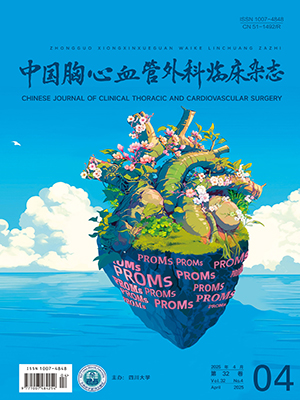| 1. |
Prêtre R, Tamisier D, Bonhoeffer P, et al. Results of the arterial switch operation in neonates with transposed great arteries. Lancet, 2001, 357(9271): 1826-1830.
|
| 2. |
Sarris GE, Chatzis AC, Giannopoulos NM, et al. The arterial switch operation in Europe for transposition of the great arteries: a multi-institutional study from the European Congenital Heart Surgeons Association. J Thorac Cardiovasc Surg, 2006, 132(3): 633-639.
|
| 3. |
Kirklin JW, Blackstone EH, Tchervenkov CI, et al. Clinical outcomes after the arterial switch operation for transposition. Patient, support, procedural, and institutional risk factors. Congenital Heart Surgeons Society. Circulation, 1992, 86(5): 1501-1515.
|
| 4. |
Yacoub MH, Radley-Smith R, Maclaurin R. Two-stage operation for anatomical correction of transposition of the great arteries with intact interventricular septum. Lancet, 1977, 1(8025): 1275-1278.
|
| 5. |
Nadal-Ginard B, Mahdavi V. Molecular basis of cardiac performance. Plasticity of the myocardium generated through protein isoform switches. J Clin Invest, 1989, 84(6): 1693-1700.
|
| 6. |
Jonas RA, Giglia TM, Sanders SP, et al. Rapid, two-stage arterial switch for transposition of the great arteries and intact ventricular septum beyond the neonatal period. Circulation, 1989, 80(3 Pt 1): I203-I208.
|
| 7. |
Mavroudis C. Anatomical repair of transposition of the great arteries with intact ventricular septum in the neonate: guidelines to avoid complications. Ann Thorac Surg, 1987, 43(5): 495-501.
|
| 8. |
Ma K, Hua Z, Yang K, et al. Arterial switch for transposed great vessels with intact ventricular septum beyond one month of age. Ann Thorac Surg, 2014, 97(1): 189-195.
|
| 9. |
Ota N, Sivalingam S, Pau KK, et al. Primary arterial switch operation for late referral of transposition of the great arteries with intact ventricular septum in the current era: do we still need a rapid two-stage operation? World J Pediatr Congenit Heart Surg, 2018, 9(1): 74-78.
|
| 10. |
Iyer KS, Sharma R, Kumar K, et al. Serial echocardiography for decision making in rapid two-stage arterial switch operation. Ann Thorac Surg, 1995, 60(3): 658-664.
|
| 11. |
Graham TP Jr. Hemodynamic residua and sequelae following intraatrial repair of transposition of the great arteries: a review. Pediatr Cardiol, 1982, 2(3): 203-213.
|
| 12. |
Lacour-Gayet F, Piot D, Zoghbi J, et al. Surgical management and indication of left ventricular retraining in arterial switch for transposition of the great arteries with intact ventricular septum. Eur J Cardiothorac Surg, 2001, 20(4): 824-829.
|
| 13. |
Aoshima M, Yokota M, Shiraishi Y, et al. The Blalock-Taussig shunt for simple complete transposition of the great arteries followed by later anatomic correction. Report of 2 cases with conflicting postoperative courses. J Cardiovasc Surg (Torino), 1986, 27(4): 503-505.
|
| 14. |
Sahu MK, Gupta A, Alam I, et al. Modified Blalock-Taussig shunt and levosimendan for left ventricular preparation in a child with transposition of great arteries and regressed ventricle undergoing rapid 2 stage arterial switch operation. Ann Card Anaesth, 2017, 20(2): 265-267.
|
| 15. |
Hörer J, Cleuziou J, Kasnar-Samprec J, et al. A comparative histopathological study of heparin coated and uncoated polytetrafluoroethylene shunts in children with congenital heart defect. World J Pediatr Congenit Heart Surg, 2014, 5(3): 385-390.
|




